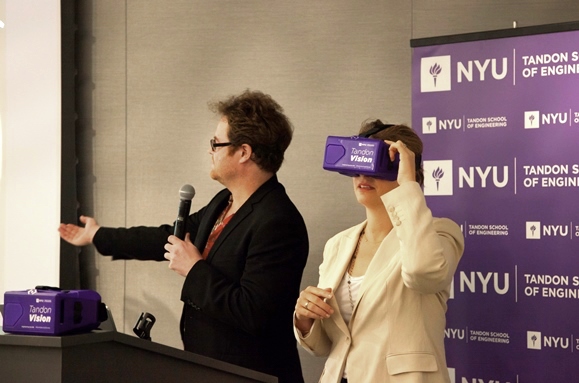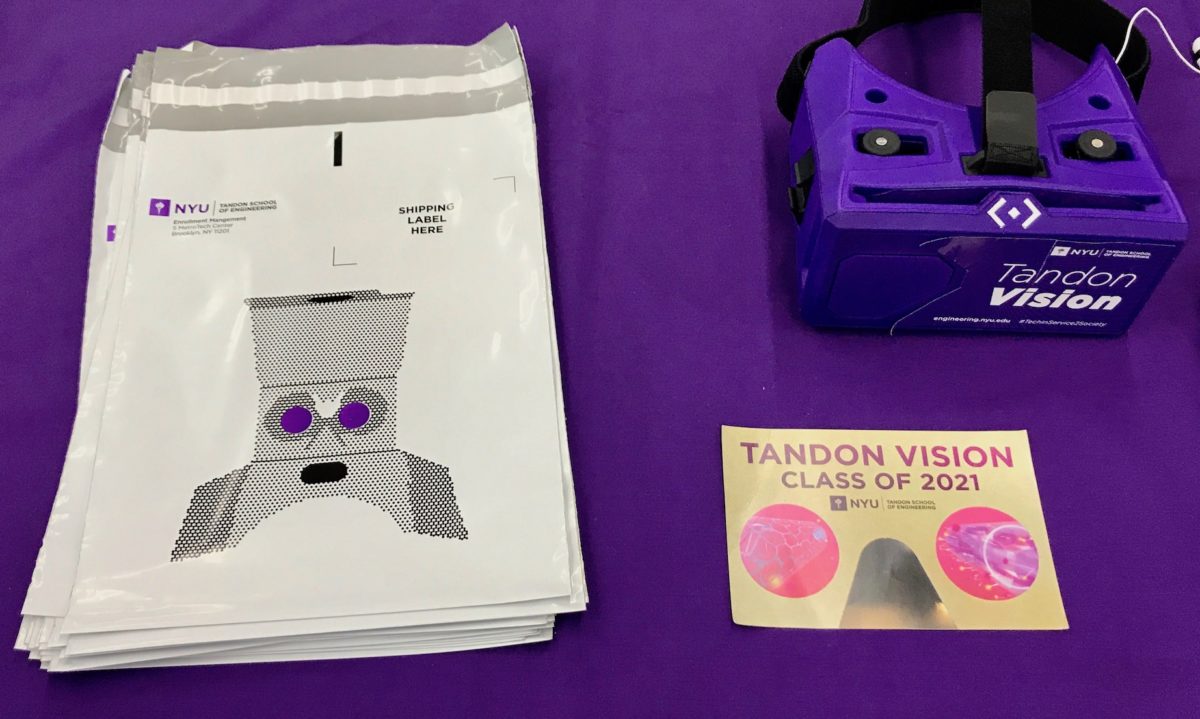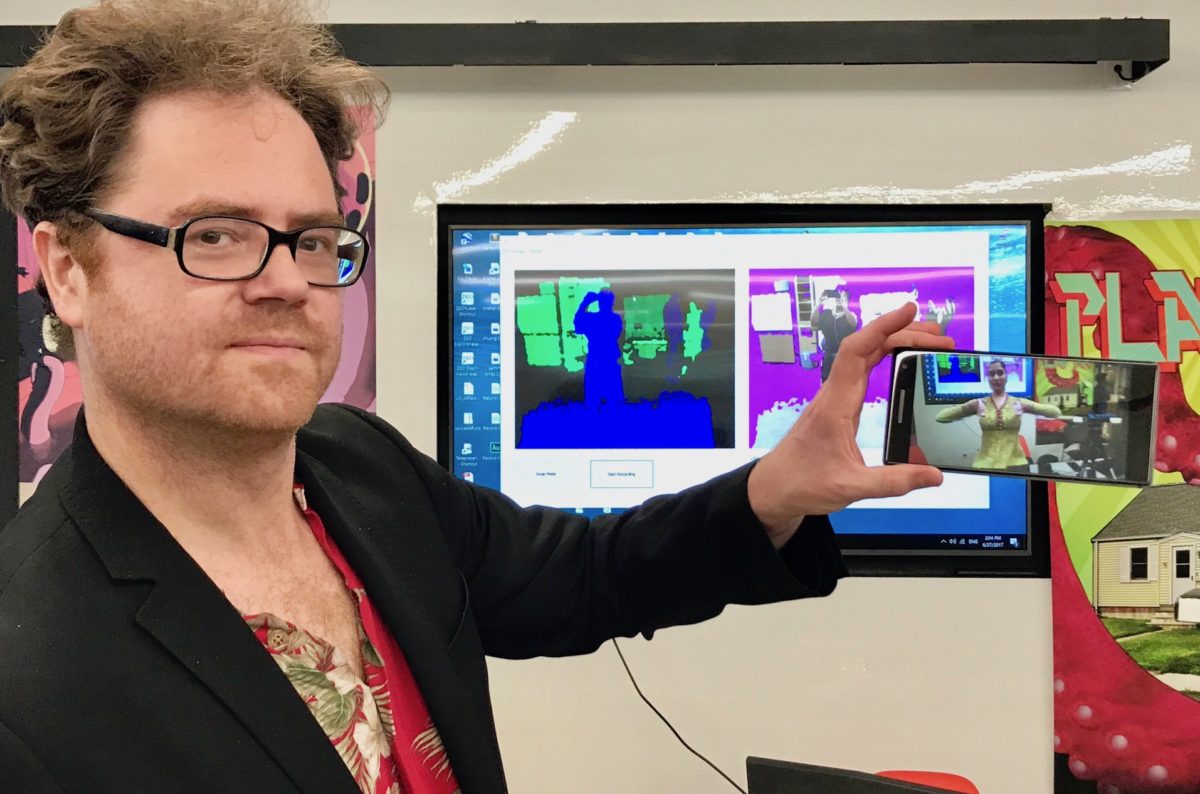Mark Skwarek is attempting to show off one of his latest developments.
It’s what Skwarek, the director of NYU’s Mobile Augmented Reality Lab, calls a “telepresence” app. Its users livestream 3D video of themselves. When recipients open the app and point their phones at their surroundings, the 3D video is placed onto the scene. In other words, you can host a video call from Brooklyn, and your friend in Beijing can talk to you as if you both were sitting in the same room.
But today, the telepresence platform isn’t quite working as it should. It takes about a half-hour for Skwarek and his lead developer, Yao Chen, to get the demo fully up and running.
No matter: this fall, Skwarek, along with other augmented- and virtual-reality creators, will have a brand new, 15,000-square-foot space in the Brooklyn Navy Yard to work out their products’ kinks.
On Tuesday, Alicia Glen, the deputy mayor for housing and economic development, announced that NYU Tandon, in partnership with CUNY’s Lehman College, have been chosen to operate the city’s new VR/AR lab. The New York City Economic Development Corporation (NYCEDC) and the Mayor’s Office of Media and Entertainment will together put $6 million toward the new lab. The city estimates it will create more than 500 jobs over the next ten years, as part of Mayor Bill de Blasio’s plan to create 100,000 quality jobs for New Yorkers.
NYU Tandon and Lehman College’s proposal for the VR/AR lab was chosen from 15 submissions. The cross-borough, public-private partnership between the two academic institutions strengthened their bid, Glen said. The Tandon-Lehman partnership, she added, epitomizes the city’s goal to build economic centers throughout New York City, not just in Manhattan.
“Our focus on building a five-borough economy is beginning to take root,” she said.

The press conference in which Glen announced the new lab inevitably featured plenty of talk about VR and AR as the next big things in tech. James Patchett, the president of the NYCEDC, Julie Menin, the commissioner of the Mayor’s Office of Media and Entertainment and City Council member Dan Garodnick, chair of the council’s committee on economic development all readily cited statistics on the industry’s projected growth. Demand for VR/AR jobs in the city, for instance, has jumped 125 percent over the past year, according to Menin’s office.
Menin also threw in a personal anecdote, gushing about her teenage sons’ love of the technology. With her work on the VR/AR lab, she said, “my coolness quotient has gone way up.”
But outside of Menin’s household, it’s likely that many New Yorkers haven’t ever tried on a VR headset or downloaded an AR app. Both technologies are currently far from the mainstream, and so far, they have limited practical applications. As cool as live VR theater is, for instance, it’s not something everyone will pony up $300 to $500 for. AR, as of now, is more accessible, but like VR, its main applications have been in cutting-edge gaming and artistic projects.
At the press conference, however, NYU Tandon offered a glimpse at how both technologies could be applied to more regular functions. Skwarek assisted Glen in demoing a VR app showcasing the work of Tandon faculty in developing a rover to explore the surface of Mars. (The demo also illustrated how unfamiliar the tech remains to the average person: Glen initially appeared a bit disoriented by the VR headset.)
That app, it turns out, is one of three that Tandon prompts incoming students to download in order to learn about the school’s research and projects. Last year, the school began sending new students Google Cardboard headsets. A few other colleges, such as Yale and Texas A&M, have begun using VR to provide virtual college tours to students who can’t make it onto campus. But Tandon uses it as a showcase for faculty research and student projects. In fact, current students even contributed to the development of the school’s latest app, said Cindy Lewis, assistant director of special events in Tandon’s office of enrollment management.

As a result, VR has become an outreach tool for Tandon. The school has demonstrated VR apps at South by Southwest and Maker Faire, which prospective students have attended to learn more about Tandon’s resources in VR. Lewis also conjectured that VR has played a big role in the school increasing its enrollment of women: this year, 40 percent of its incoming freshman class is female. That’s double the percentage of women who earn bachelor’s degrees in engineering across the U.S.
“It’s something that really draws them in,” she said.
Then, of course, there’s the work of Skwarek, who also runs a company called Semblance AR, which develops augmented reality apps. While most VR hardware is years away from mainstream adoption, AR, for the most part, only requires a smartphone. While the telepresence app is a fairly cutting-edge example of the technology, it’s analogous to a souped-up version of Skype — in other words, it’s something that has the potential to be used on a regular basis.
Skwarek also demoed a navigation app that projects a line onto the screen to give its users turn-by-turn directions within enclosed areas such as airports and shopping malls. (Penn Station, notorious for its awful signage, could certainly use the technology.) He gave an example use case: say you’re at the gate for your flight, but then you find out you’ve been moved to another gate — in a different terminal. The app could help reduce the resultant confusion and panic: there is nothing, after all, like the fear of missing a flight.
It’s those sorts of everyday situations that Semblance AR is targeting.
“Our mantra,” Skwarek said, “is to bring this technology to the general public, now.”







